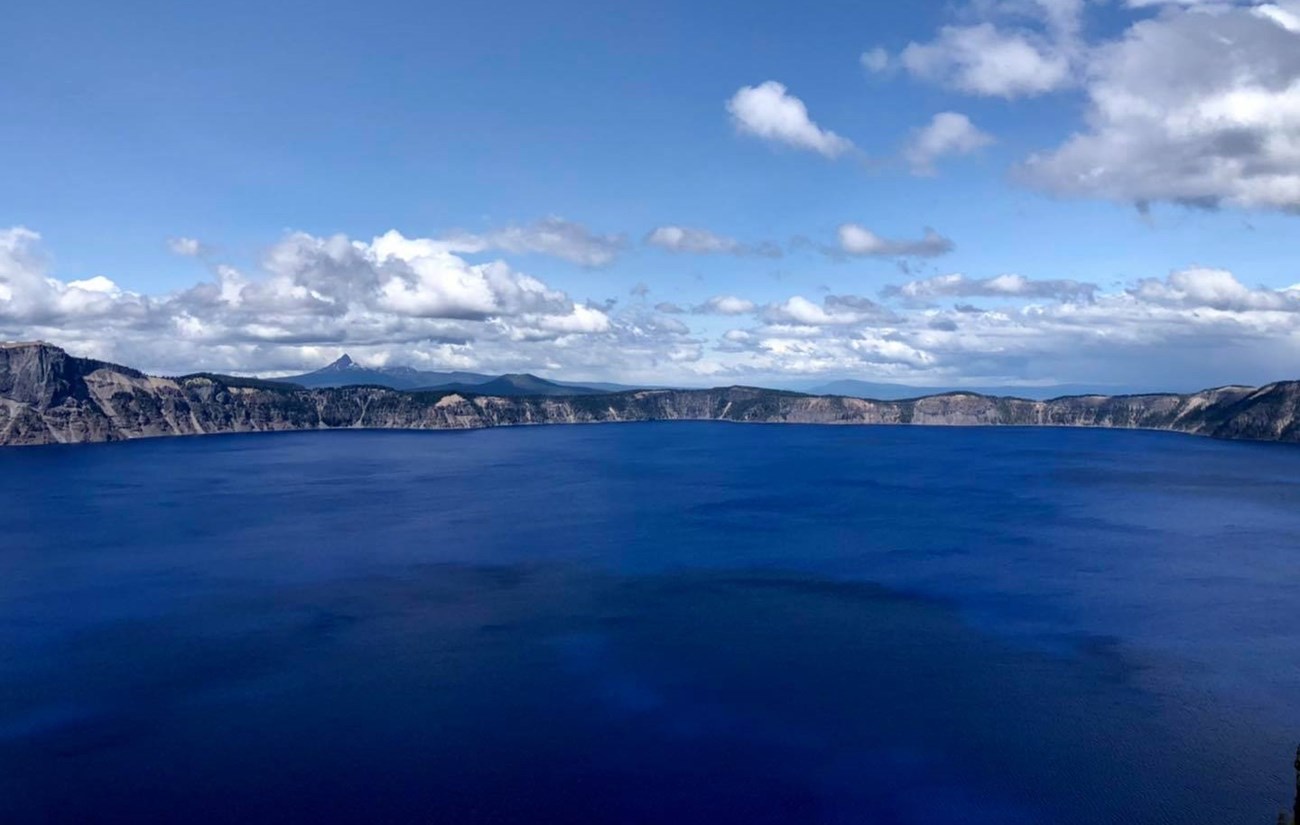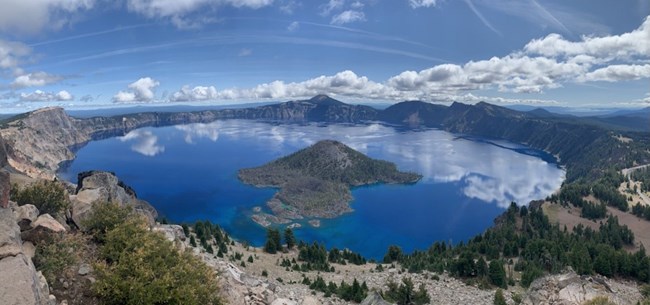
NPS/photo by Kim Chamales 2021 First There Was a MountainA massive eruption occurred about 7,700 years ago. It was followed by ejections of volcanic matter through fractures, in an oval shape around the mountain. These events weakened the mountain's structure, and caused the central portion of Mount Mazama to collapse inward. The result was an 5–6 mi (8–10 km) diameter and 0.7 mi (1.2 km) deep caldera.Before the collapse, Mount Mazama loomed at approximately 12,000 ft (3,658 m) tall. Today, the highest point along the rim is Hillman Peak at 8,151 ft (2,484 m) and the highest point in the park is Mount Scott at 8,929 ft (2722 m). 
NPS Photo/Kim Chamales Now There is a LakeSoon after the caldera formed, eruptions from new vents built the base of Wizard Island, and over several hundred years, rain and snow partially filled the caldera. Meanwhile, Wizard Island continued to grow and three other volcanoes formed underwater. The final eruption was on the east flank of Wizard Island about 4,800 years ago.Evaporation and seepage are equal forces which keep Crater Lake from filling beyond an average depth of 1,943 ft (592 m) or 4.9 trillion gal (18.6 trillion L) of water. About 34 billion gal (128 billion L) are gained and lost each year. The yearly average snowfall on Crater Lake, as of 2020, is 42 ft (13 m) with an average yearly precipitation (rain and melted snow) of 67 in (2 m). Average snowfall has been decreasing since the 1930's when it was recorded at 51 ft (16 m). Widely known for its rich blue color and extreme clarity, which averages 102 ft (31m) deep, Crater Lake is the deepest lake in the United States. It is one of the top ten deepest in the world. Unlike other Cascade Mountain lakes, Crater Lake rarely freezes over in the winter due to the heat content of the enormous water volume. To learn about lake ecology, current research, and the Long-term Limnological Monitoring Program, visit Crater Lake Research. Beyond Blue The mystique of Crater Lake begins with the public’s fascination of the lake's color, depth, and clarity. The lake's formation and existence is explained through a collaboration of many sciences, along with human stories and experiences. Click on one of the items below for information about some of the lakes features and past explorations. Click here to access a yearly account of the Crater Lake Long-term Limnological Monitoring Program.
State of the Lake Report: 2020. Curiosity abounds about life in Crater Lake. Well... mostly, people want to know if there are fish in the lake. Yes, there are nonnative fish, but what else?
Hidden beneath the lake's surface between 85-460 ft (26-140 m) deep, moss hangs like icicles. It thrives on the near vertical walls of the caldera and forms thick fields on gentler slopes around Wizard Island. The moss was first discoverred and sampled during the Deep Rover Submarine Program in 1988-89. This deep-water moss is believed to represent the bulk of the biomass in Crater Lake.
A remarkable feature of the moss, are the thick deposits of peat—up to 30 feet (9 m)—created by centuries of moss growth. Lake biologists knew it existed because the peat occurs in relatively shallow water around Wizard Island. Some of these mats have holes, called fumeroles, wide and deep enough for divers to explore. Click on this link to see a video of the moss. In the summers of 1987,' 88 and '89, the National Park Service, US Geological Survey, and National Geographic Society teamed up to lease a submarine called Deep Rover. With one researcher aboard, Deep Rover made 47 dives to the bottom. The purpose was to collect data on the lake’s hydrology, biology, and geology and to resolve a controversy over geothermal energy development that was brewing on the borders of the national park. A few of the discoveries include:
Is it a mystery, a phenomenon, or simply part of a tree that is vertical and drifting around the lake?
Perhaps the Old Man of the Lake is all three as its character simultaneously delights and eludes visitors hoping to see him from the rim.
Click on the link for photos and stories about the Old Man. An automated weather station is attached to a buoy near the deepest part of Crater Lake. It reports hourly data to a publicly available website operated by the University of Utah - Department of Atmospheric Sciences. The data obtained from this weather station assists park researchers in understanding climate change, the effects of air and water temperature on lake currents, and other significant lake developments. The following data is collected by the weather station:
|
Last updated: September 8, 2023
